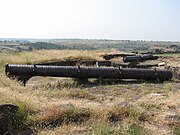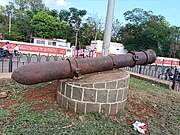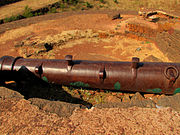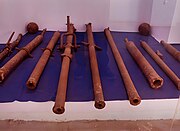Gunpowder weapons in the Bahmani Sultanate
This article needs additional citations for verification. (April 2024) |
The

Weapons development

The Bara Gazi Toph holds the title of the longest cannon in the world. It was commissioned by Alaudin Bahman Shah in 1347, showcasing the advanced artillery of the Bahmani Sultanate during its era. Crafted from an alloy known as panch dhatu, it stands as a testament to the technological prowess of its time. Measuring approximately 29 feet in length with a circumference of 7.6 feet, a diameter of 2 feet, and a thickness of 7 inches, the cannon is considerably large. Its top portion has 20 rings, indicating that during wartime, it required the strength of twenty soldiers to maneuver it. Unfortunately, due to neglect and inadequate security measures, only five of these rings remain today. According to photographer Mohammed Ayazuddin, the estimated weight of the cannon is around 80 tons.[3]

Paranda Fort was possibly constructed by Mahmud Gawan. The fort represents an example of military architecture and engineering and served as military base for the Bahmani Sultanate & other Deccan sultanates.[4] In January 1471, Mahmud Gawan, the Wazir (Prime Minister) of the Bahmani Sultanate, utilized heavy cannons and explosive mines to demolish the Fort of Machal. Following the capture of Goa Port from the Hindu Vijayanagara Empire in 1472, Mahmud Gawan dispatched Bahmani agents to Egypt and Anatolia to trade Indian textiles and spices.
The historian
Other gunpowder weapons
The Bahmani Sultanate also utilized hand cannons,
-
Muskets from the Bahmanid era at the Bidar Fort Museum
-
Bahmani's era Cannons in Paranda fort
-
Bahmani and Adil Shahi era Cannons located at Naldurg fort
-
A Bahmani's era Cannon Located at Bidar Fort
-
Another cannon in the Bidar Fort
-
Hand cannons from the Bahmanid era at the Bidar Fort Museum
References
- ^ ISBN 978-1-78093-813-4.
- JSTOR 3631993. Retrieved 2024-04-11.
- ^ YMD (2018-06-12). "World's Longest Cannon in Bahmani Fort". Young Muslim Digest. Retrieved 2024-04-10.
- ^ "Top thing to do in Paranda Fort (2024) | All about Paranda Fort, Osmanabad, Maharashtra". www.tripnight.com. Retrieved 2024-04-10.






